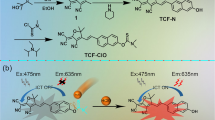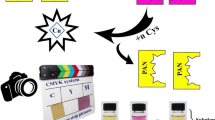Abstract
The copper(II) ion (Cu2+) has played an indispensable role in diverse kinds of functional physiological processes of organisms, which has become of growing interest. Despite the fact that numerous Cu2+ test papers using fluorescent probes have been fabricated, sensors featuring the ratiometric property that integrates quenched probes and an inner standard dye are rarely reported. Herein, a two-component ratiometric sensor in a paper-based device is proposed to realize highly selective Cu2+ detection. To overcome shortcomings such as low signal-to-noise ratio and incorrect response of the quenching probe, a novel BODIPY-based turn-off probe (P2017) is designed and introduced into the paper-based device with better water solubility and selectivity for Cu2+ detection. Furthermore, a reference dye (B001), exhibiting an emission at 690 nm when the excitation wavelength is 480 nm, is also introduced into the paper-based device. These two components can enhance the quality of the signal as P2017 is sensitively quenched by Cu2+, while B001 with a photostable property, serving as an internal benchmark, is unable to react with Cu2+. The results indicated that the two components provided a new concept for optimizing paper-based device fabrication and developing accurate, simple, and inexpensive Cu2+ detection methods, which could be potentially applied to monitor human health and the environment in remote areas.

Graphical abstract





Similar content being viewed by others
References
Maity D, Manna AK, Karthigeyan D, Kundu TK, Pati SK, Govindaraju T. Visible-near-infrared and fluorescent copper sensors based on julolidine conjugates: selective detection and fluorescence imaging in living cells. Chem Eur. 2011;17:11152–61.
Li ZF, Mei L, Xiang Y, Tong AJ. Novel colorogenic probe of rhodamine B derivative for the detection of copper ion. Chin J Anal Chem. 2008;36:915–9.
Jung HS, Kwon PS, Lee JW, Kim JI, Hong CS, Kim JW, et al. Coumarin-derived Cu2+-selective fluorescence sensor: synthesis, mechanisms, and applications in living cells. J Am Chem Soc. 2009;131:2008–12.
Okamoto S, Eltis LD. The biological occurrence and tracking of cobalt. Metallomics. 2011;3:963–70.
Que EL, Domaille DW, Chang CJ. Metals in neurobiology: probing their chemistry and biology with molecular imaging. Chem Rev. 2008;108:1517–49.
Tapiero H, Toensend DM, Tew KD. Trace elements in human physiology and pathology copper. Biomed Pharmacother. 2003;57:386–98.
Yin S, Leen V, Van Snick S, Boens N, Dehaen W. A highly sensitive, selective, colorimetric and near-infrared fluorescent turn-on chemosensor for Cu2+ based on BODIPY. Chem Commun. 2010;46:6329–31.
Li J, Huo F, Yin C. Cu2+ biological imaging probes based on different sensing mechanisms. Curr Med Chem. 2018;25:1–44.
Yang XJ, Li ML, Bai JH. Determination of heavy metal ions in waste water by the flame atomic absorption spectrometry. Chin J Spectrosc Lab. 2010;27:247–9.
Shanmugaraj K, Ilanchelian M. A turn-off fluorescent sensor for the selectiveand sensitive detection of copper(II) ions using lysozyme stabilized goldnanoclusters. RSC Adv. 2016;6:54518–24.
Fu YL, Fan CB, Liu G, Pu SZ. A colorimetric and fluorescent sensor for Cu2+ and F− based on a diarylethene with a 1,8-naphthalimide Schiff base unit. Sensors Actuators B Chem. 2017;239:295–303.
Martinez AW, Phillips ST, Butte MJ, Whitesides GM. Patterned paper as a platform for inexpensive, low-volume, portable bioassays. Angew Chem Int Ed. 2007;46:1318–20.
López-Marzo AM, Merkoçi A. Paper-based sensors and assays: a success of the engineering design and the convergence of knowledge areas. Lab Chip. 2016;16:3150–76.
Zhang L, Zhou M, Wen D, Bai L, Lou B, Dong S. Small-size biofuel cell on paper. Biosens Bioelectron. 2012;35:155–9.
Cinti S, Fiore L, Massoud R, Cortese C, Moscone D, Palleschi G, et al. Low-cost and reagent-free paper-based device to detect chloride ions in serum and sweat. Talanta. 2018;179:186–92.
Yang Y, Noviana E, Nguyen MP, Geiss BJ, Dandy DS, Henry CS. Paper-based microfluidic devices: emerging themes and applications. Anal Chem. 2017;89:71–91.
Zhang W, Zhang X, Lu C, Wang Y, Deng Y. Flexible and transparent paper-based ionic diode fabricated from oppositely charged microfibrillated cellulose. J Phys Chem C. 2012;116:9227–34.
Yetisen AK, Akram MS, Lowe CR. Paper-based microfluidic point-of-care diagnostic devices. Lab Chip. 2013;13:2210–51.
Medina-Sánchez M, Cadevall M, Ros J, Merkoçi A. Eco-friendly electrochemical lab-on-paper for heavy metal detection. Anal Bioanal Chem. 2015;407:8445–9.
Russo A, Ahn BY, Adams JJ, Duoss EB, Bernhard JT, Lewis JA. Pen-on-paper flexible electronics. Adv Mater. 2011;23:3426–30.
Li B, Zhang W, Chen L, Lin B. A fast and low-cost spray method for prototyping and depositing surface-enhanced Raman scattering arrays on microfluidic paper based device. Electrophoresis. 2013;34:2162–8.
Cai YQ, You JH, You ZY, Dong F, Du S, Zhang L. Profuse color-evolution-based fluorescent test paper sensor for rapid and visual monitoring of endogenous Cu2+ in human urine. Biosens Bioelectron. 2018;99:332–7.
Liu X, Yang Y, Xing X, Wang Y. Grey level replaces fluorescent intensity: fluorescent paper sensor based on ZnO nanoparticles for quantitative detection of Cu2+ without photoluminescence spectrometer. Sensors Actuators B Chem. 2018;255:2356–66.
Wang YH, Zhang C, Chen XC, Yang B, Yang L, Jiang C, et al. Ratiometric fluorescent paper sensor utilizing hybrid carbon dots-quantum dots for the visual determination of copper ions. Nanoscacle. 2016;11:5977–84.
Zhu M, Wang L, Wu X, Na R, Wang Y, Li QX, et al. A novel and simple imidazo[1,2-a]pyridin fluorescent probe for the sensitive and selective imaging of cysteine in living cells and zebrafish. Anal Chim Acta. 2019;1058:155–65.
Huang Y, Li CF, Shi WJ, Tan HY, He ZZ, Zheng L, et al. A near-infrared BODIPY-based fluorescent probe for ratiometric and discriminative detection of Hg2+ and Cu2+ ions in living cells. Talanta. 2019;198:390–7.
Boens N, Leen V, Dehaen W. Fluorescent indicators based on BODIPY. Chem Soc Rev. 2012;41:1130–72.
Liu K, Zhang Y, Zhou T, Liu X, Chen B, Wang X, et al. Sequential recognition of Hg2+ and I− based on a novel BODIPY-salen sensor. Sensors Actuators B Chem. 2017;253:1194–8.
Zhou Y, Xiao Y, Li D, Fu M, Qian X. Novel fluorescent fluorine–boron complexes: synthesis, crystal structure, photoluminescence, and electrochemistry properties. J Org Chem. 2008;73:1571–4.
He X, Zhang J, Liu X, Dong L, Li D, Qiu H, et al. A novel bodipy-based colorimetric and fluorometric dual-mode chemosensor for Hg2+ and Cu2+. Sensors Actuators B Chem. 2014;192:29–35.
Zhou J, Ni Y, Zhang CW, Zhang GB, Li L. Design and synthesis of pyrimidine based two-photon fluorescence probe and its application in bioimaging. Chin J Appl Chem. 2017;34:1450–6.
Liu B, Zhang HL, Liu J, Zhao YD, Luo QM, Huang ZL. Novel pyrimidine-based amphiphilic molecules: synthesis, spectroscopic properties and applications in two-photon fluorescence microscopic imaging. J Mater Chem. 2007;28:2921–9.
Bartelmess J, Weare WW. Preparation and characterization of multi-cationic BODIPYs and their synthetically versatile precursors. Dyes Pigments. 2013;97:1–8.
Yang Y, Zhang L, Li B, Zhang L, Liu X. Triphenylamine-cored tetramethyl-bodipy dyes: synthesis, photophysics and lasing properties in organic media. RSC Adv. 2013;3:14993–6.
Erbas S, Gorgulu A, Kocakusakogullari M, Akkaya EU. Non-covalent functionalized SWNTs as delivery agents for novel Bodipy-based potential PDT sensitizers. Chem Commun. 2009;33:4956–8.
Wang K, Qian J, Jiang D, Yang ZT, Du XJ, Wang K. On site naked eye determination of cysteine and homocysteine using quencher displacement-induced fluorescence recovery of the dual- emission hybrid probes with desired intensity ratio. Biosens Bioelectron. 2015;65:83–90.
Zhang K, Yu T, Liu F, Sun MT, Yu H, Liu BH, et al. Selective fluorescence turn-on and ratiometric detection of organophosphate using dual-emitting Mn-doped ZnS nanocrystal probe. Anal Chem. 2014;86:11727–33.
Tsay OG, Leea KM, Churchill DG. Selective and competitive cysteine chemosensing: resettable fluorescent “turn on” aqueous detection via Cu2+ displacement and salicylaldimine hydrolysis. New J Chem. 2012;36:1949–52.
Funding
This work was financially supported by the National Natural Science Foundation of China (81672508 and 61601218), Jiangsu Provincial Foundation for Distinguished Young Scholars (BK20170041, BK20170042), Natural Science Foundation of Shaanxi Province (2019JM-016), China-Sweden Joint Mobility Project (51811530018), and Fundamental Research Funds for the Central Universities.
Author information
Authors and Affiliations
Corresponding authors
Ethics declarations
Conflict of interest
The authors declare that there are no conflicts of interest.
Additional information
Publisher’s note
Springer Nature remains neutral with regard to jurisdictional claims in published maps and institutional affiliations.
Electronic supplementary material
ESM 1
(PDF 491 kb)
Rights and permissions
About this article
Cite this article
Zhou, J., Wu, Q., Chen, X. et al. Two-component ratiometric sensor for Cu2+ detection on paper-based device. Anal Bioanal Chem 411, 6165–6172 (2019). https://doi.org/10.1007/s00216-019-02007-6
Received:
Revised:
Accepted:
Published:
Issue Date:
DOI: https://doi.org/10.1007/s00216-019-02007-6




